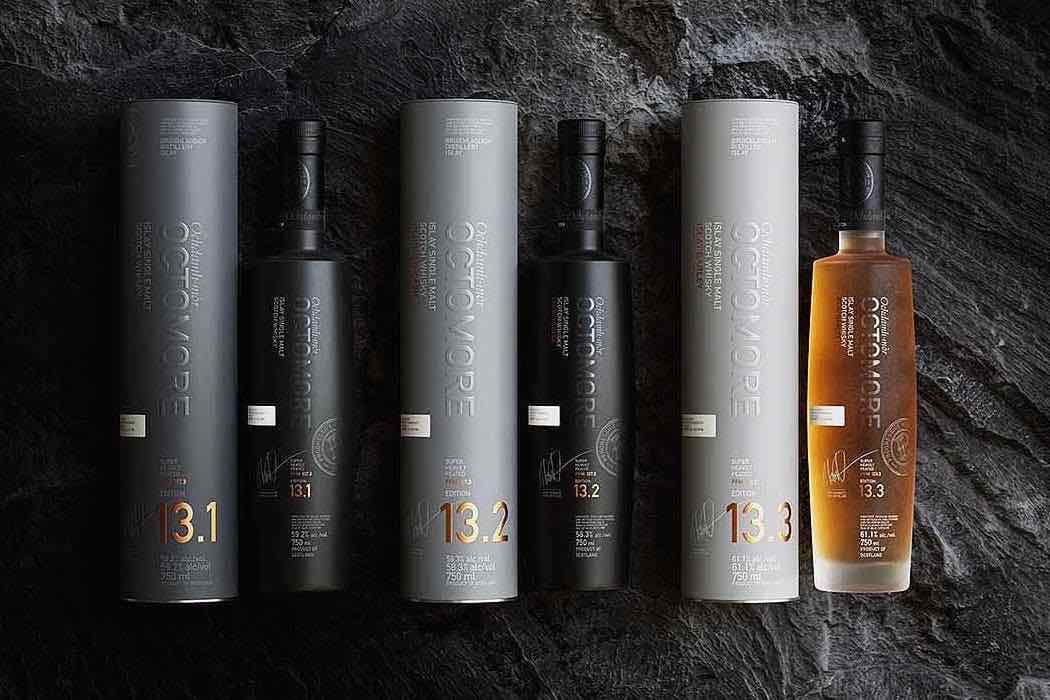Bruichladdich has roots dating back to 1881, but the modern incarnation of the Islay-based distillery began in 2001, when wine and spirits merchant Mark Reynier and Master Distiller Jim McEwan resurrected the operation following its 1993 shuttering.
Over the ensuing years, the enterprising brand supplemented the unpeated Bruichladdich label with peated Port Charlotte and extra-peated Octomore, which holds the title of the world’s most heavily peated single malt. The distillery set out to be pioneers, provocateurs, and change makers, and they haven’t strayed from that ethos.
Master Distiller Adam Hannett took the reins from McEwan in 2015. Born and raised on Islay, he’s been working at Bruichladdich for 18 years, and it’s his job to make the core expressions while continuing to push the envelope. Those efforts are evident in recent releases, including the new Bruichladdich Islay Barley 2013 and the just-released Octomore 13.
Bruichladdich Islay Barley showcases the island’s grain, and the 2013 release is the eighth edition of the unpeated, locally grown single malt. Its label is a good read, with a map, the names of the seven farms that grew the crops, and an eight-year age statement noting the maturation vessels—a combination of ex-American and ex-European oak casks. For Hannett, sharing these details is core to the distillery’s DNA.
“We’re not talking about bagpipes and tartan,” says Hannett. ‘The story we tell is the story of the whisky. And the least we can do is be as honest and as transparent as we can.”
Creating a whisky with local grain isn’t a new practice, but on the tiny island of Islay, it means resigning the spirit to a relatively small release. If you’re able to score a bottle, you’ll find a bright and lively dram, with notes of lemon, honey, vanilla, and oak spice, all tied up in a bow of mild island salinity.

Octomore falls on the opposite end of the spectrum. This annual release is always matured for five years, super-heavily peated, and bottled close to cask strength. Originally launched in 2008, the line was created in part to show how good a young whisky can be when it’s treated right. It’s often called “the impossible equation” because the whiskies just shouldn’t work: they’re too young, too smoky, too strong. It’s now in its 13th edition.
Octomore is released as a series, so you’ll need to parse some decimal points. Octomore 13.1 is matured in American oak casks, Octomore 13.2 is aged entirely in Oloroso sherry butts, and Octomore 13.3 is made from 100% Islay barley and aged in a combination of first-fill American oak and second-fill European oak. Each expression falls between 129 and 137 PPM, a measurement denoting its very high peat level. For reference, other “heavily peated” scotch whiskies might fall between 30 to 40 PPM.
During a recent meeting with Hannett, he also showed off the new Black Art 10, which will be released on November 1. The mysterious dram is the only whisky in the Bruichladdich portfolio that’s purposely opaque. Other than a 29-year age statement, its makeup is a total secret.
“The opportunity is there to do so much,” says Hannett. “Rather than do the same thing each year, we have the freedom to explore.”
The Black Art 10’s nose seems to go on forever, with a deep and dark character. After I get lost in the aromas, Hannett offers some encouragement: “You almost don’t need to drink it—but you should.”



